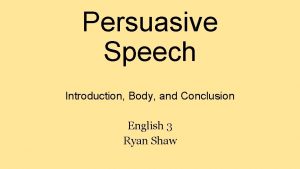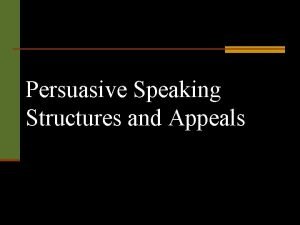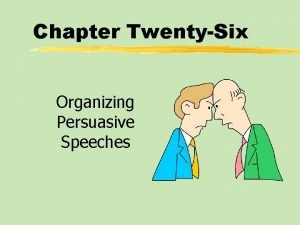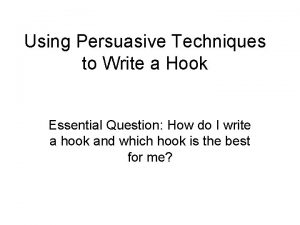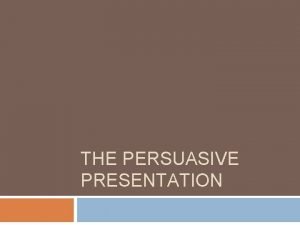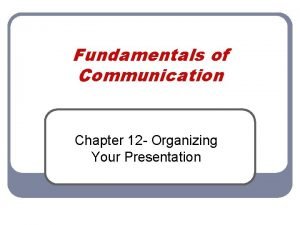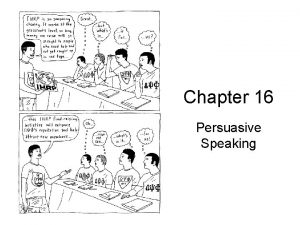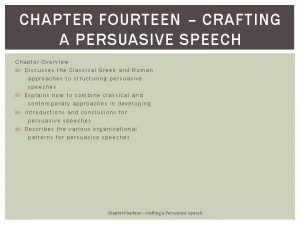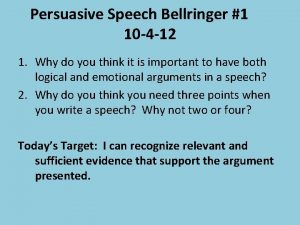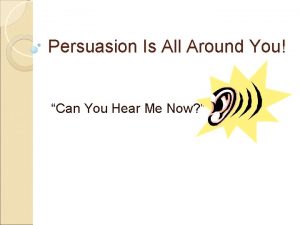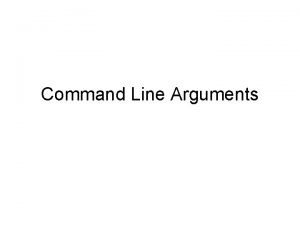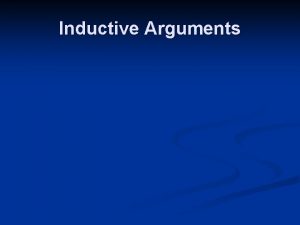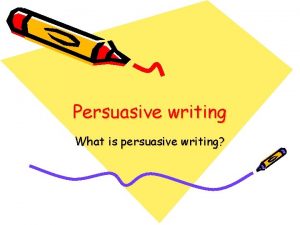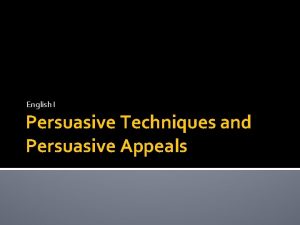Chapter TwentyFive Developing Arguments for the Persuasive Speech
























- Slides: 24

Chapter Twenty-Five Developing Arguments for the Persuasive Speech

Chapter Twenty Five Table of Contents z. What is an Argument? z. Variations in Argument: Types of Claims, Evidence, and Warrants z. Fallacies in Reasoning

What is an Argument? z. Argument: a stated position with support for or against an idea or issue.

What is an Argument? z. Stating a Claim z. Providing Evidence z. Giving Warrants

What is an Argument? Stating a Claim z. Claim: declares a state of affairs, often stated as a thesis statement. z. Answers the question, “What are you trying to prove? ”

What is an Argument? Providing Evidence z. Evidence: material that provides grounds for belief in a claim. z. For example, statistics, testimony, facts, examples, and narratives.

What is an Argument? Providing Evidence z. The goal of evidence is to make a claim more acceptable or believable to the audience.

What is an Argument? Giving Warrants z. Warrant: a statement that provides the logical connection between evidence and a claim.

What is an Argument? Giving Warrants z. Write down the claim. z. List each possible piece of evidence you have in support of the claim. z. Write down the corresponding warrants that link the evidence to the claim.

Variations in Argument: Types of Claims, Evidence, and Warrants z. Types of Claims z. Types of Evidence z. Types of Warrants z. Addressing the Other Side

Variations in Argument: Types of Claims z. Claims of fact: focus on whether something is or is not true, or will not happen z. Claims of value: address issues of judgment z. Claims of policy: recommend a specific course of action to be approved of or taken

Variations in Argument: Types of Evidence z. Audience Knowledge and Opinions z. Speaker Knowledge and Opinions z. External Evidence

Variations in Argument: Types of Warrants z. Motivational warrants: focus on the needs, desires, emotions, and values of audience. z. Authoritative warrants: rely on the audience’s beliefs about the credibility or acceptability of a source of evidence.

Variations in Argument: Types of Warrants z. Substantive warrants operate on the basis of an audience’s beliefs about the reliability of factual evidence.

Variations in Argument: Types of Warrants z. Warrants by cause: offer a cause-andeffect relationship as proof for a claim z. Warrants by analogy: compare two similar cases and infer that what is true in one is true in the other

Variations in Argument: Types of Warrants z. Warrants by sign: infer that such a close relationship exists between two variables that the presence or action of one may be taken as the presence or action of the other.

Variations in Argument: Addressing the Other Side z. All attempts at persuasion are subject to counter persuasion. z. Inoculation effect: by anticipating counterarguments and addressing or rebutting them, you can “inoculate” your listeners against the “virus” of these other viewpoints.

Fallacies in Reasoning: The Pitfalls of Arguing z. Logical fallacy: a false or erroneous statement, or an invalid or deceptive line of reasoning. z. Be aware of fallacies!

Fallacies in Reasoning: The Pitfalls of Arguing z. Begging the Question z. Bandwagoning z. Either-Or Fallacy z. Ad Hominem Argument z. Red Herring

Fallacies in Reasoning: Begging the Question z. Stating an argument in such a way that it cannot help but be true even though no evidence has been presented.

Fallacies in Reasoning: Bandwagoning z. Phrasing arguments as if they were true because “general opinion” supports them.

Fallacies in Reasoning: Either-Or Fallacy z. Poses an argument in terms of two alternatives only, even though there may be multiple ways of viewing the issue.

Fallacies in Reasoning: Ad Hominem Argument z. Attacking an opponent instead of the opponent’s argument.

Fallacies in Reasoning: Red Herring z. Arguments that rely on irrelevant information.
 Persuasive speech vs informative speech
Persuasive speech vs informative speech Informative vs persuasive
Informative vs persuasive Say again persuasive techniques
Say again persuasive techniques Conclusion for persuasive speech
Conclusion for persuasive speech Persuasive speech structures
Persuasive speech structures Persuasive and informative speech
Persuasive and informative speech Informative vs persuasive
Informative vs persuasive Comparative advantage persuasive speech
Comparative advantage persuasive speech Hook for persuasive essay
Hook for persuasive essay What is presentation
What is presentation Persuasive speech on buying a house
Persuasive speech on buying a house Rap lyrics on trial ethos pathos logos
Rap lyrics on trial ethos pathos logos Amtobul meaning
Amtobul meaning Value persuasive speech
Value persuasive speech How to organize a persuasive speech
How to organize a persuasive speech Definition of persuasive speech
Definition of persuasive speech Problem cause solution speech
Problem cause solution speech Speech therapy tattoos
Speech therapy tattoos 12-1 reported speech #1
12-1 reported speech #1 What is persuasion
What is persuasion What is persuasive speech
What is persuasive speech Higher persuasive essay
Higher persuasive essay What is persuasive speech
What is persuasive speech Warrant in persuasive speech
Warrant in persuasive speech Fspos vägledning för kontinuitetshantering
Fspos vägledning för kontinuitetshantering



